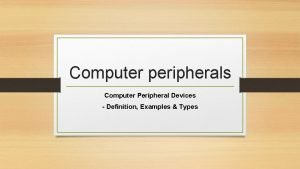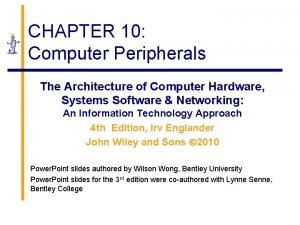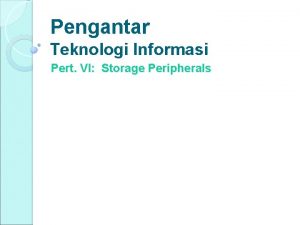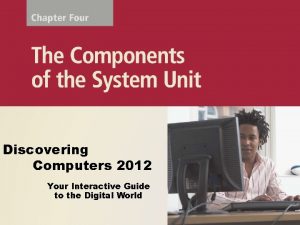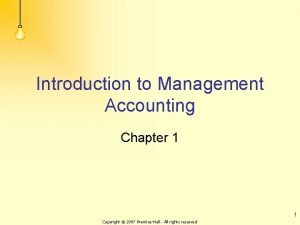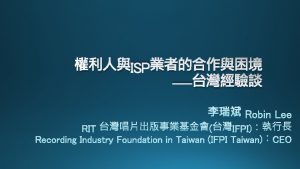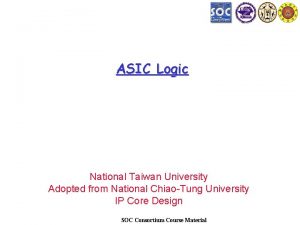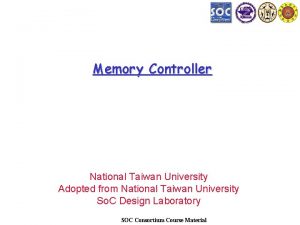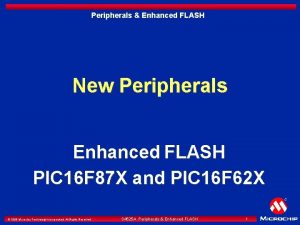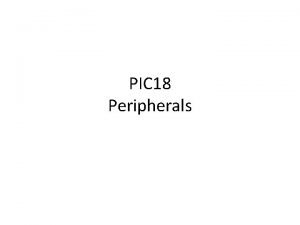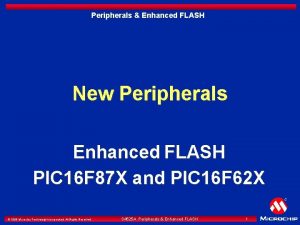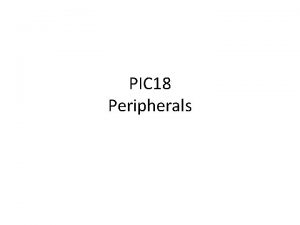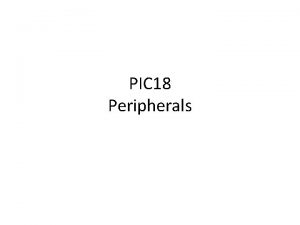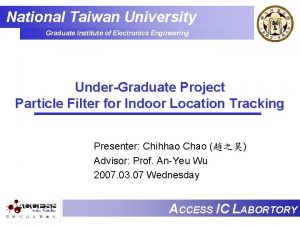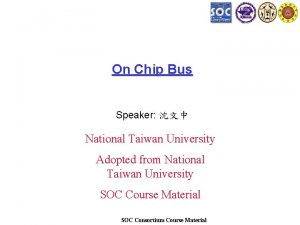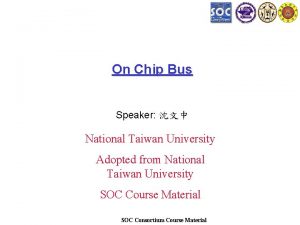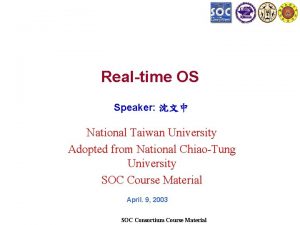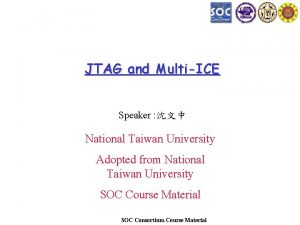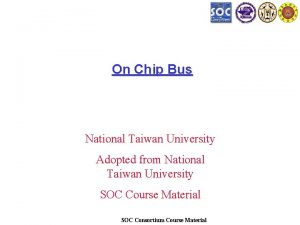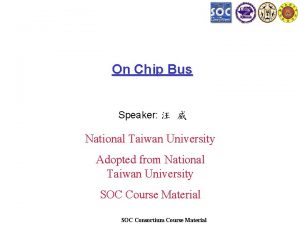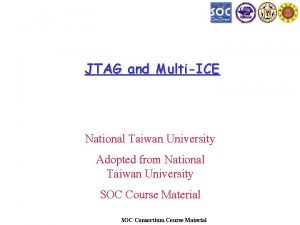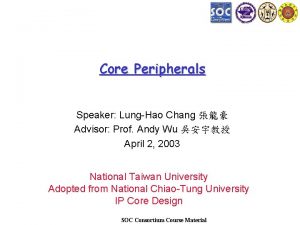Core Peripherals National Taiwan University Adopted from National


![Outline q ARM Integrator Core Module (CM) [1] q ARM Integrator Logic Module (LM) Outline q ARM Integrator Core Module (CM) [1] q ARM Integrator Logic Module (LM)](https://slidetodoc.com/presentation_image_h2/591a24ee172e3ad9a37e7966749dfdcc/image-3.jpg)






![Outline q ARM Integrator Core Module (CM) [1] q ARM Integrator Logic Module (LM) Outline q ARM Integrator Core Module (CM) [1] q ARM Integrator Logic Module (LM)](https://slidetodoc.com/presentation_image_h2/591a24ee172e3ad9a37e7966749dfdcc/image-10.jpg)





![Outline q ARM Integrator Core Module (CM) [1] q ARM Integrator Logic Module (LM) Outline q ARM Integrator Core Module (CM) [1] q ARM Integrator Logic Module (LM)](https://slidetodoc.com/presentation_image_h2/591a24ee172e3ad9a37e7966749dfdcc/image-16.jpg)






















![Outline q ARM Integrator Core Module (CM) [1] q ARM Integrator Logic Module (LM) Outline q ARM Integrator Core Module (CM) [1] q ARM Integrator Logic Module (LM)](https://slidetodoc.com/presentation_image_h2/591a24ee172e3ad9a37e7966749dfdcc/image-39.jpg)


![Outline q ARM Integrator Core Module (CM) [1] q ARM Integrator Logic Module (LM) Outline q ARM Integrator Core Module (CM) [1] q ARM Integrator Logic Module (LM)](https://slidetodoc.com/presentation_image_h2/591a24ee172e3ad9a37e7966749dfdcc/image-42.jpg)


![References [1] http: //twins. ee. nctu. edu. tw/courses/ip_core_02/index. html [2] DUI 0126 B_CM 7 References [1] http: //twins. ee. nctu. edu. tw/courses/ip_core_02/index. html [2] DUI 0126 B_CM 7](https://slidetodoc.com/presentation_image_h2/591a24ee172e3ad9a37e7966749dfdcc/image-45.jpg)
- Slides: 45

Core Peripherals National Taiwan University Adopted from National Chiao-Tung University IP Core Design SOC Consortium Course Material

Goal of This Lab q Familiarize with ARM Hardware Development Environment – ARM Integrator/AP – Core Module – Logic Module q How to use Timer/Interrupt SOC Consortium Course Material 1
![Outline q ARM Integrator Core Module CM 1 q ARM Integrator Logic Module LM Outline q ARM Integrator Core Module (CM) [1] q ARM Integrator Logic Module (LM)](https://slidetodoc.com/presentation_image_h2/591a24ee172e3ad9a37e7966749dfdcc/image-3.jpg)
Outline q ARM Integrator Core Module (CM) [1] q ARM Integrator Logic Module (LM) [2] q ARM Integrator ASIC Application Platform (AP) [3] q System Memory Map [1] q Lab 3 – Core Peripheral SOC Consortium Course Material 2

ARM Integrator Core Module/CM q CM provides ARM core personality. q CM could be used as a standalone development system without AP. q CM could be mounted onto AP as a system core. q CM could be integrated into a 3 rd-party development or ASIC prototyping system. SOC Consortium Course Material 3

Core module SOC Consortium Course Material 4

ARM Integrator/CM Feature (CM 9 TDMI) q ARM 9 TDMI microprocessor core – ARM 940 T/ARM 920 T q Core module controller FPGA : – – SDRAM controller System bus bridge Reset controller Interrupt controller q Supports 16 MB~256 MB PC 66/PC 100 168 pin SDRAM q Supports 256/512 KB SSRAM q Multi-ICE, logic analyzer, and optional trace connectors. SOC Consortium Course Material 5

FPGA functional diagram SOC Consortium Course Material 6

ARM Integrator Core Module FPGA q SDRAM controller – Supports for DIMMs from 16 MB to 256 MB. q Reset controller – Initializes the core. – Process resets from different sources. q Status and configuration space – Provides processor information. – CM oscillator setup. – Interrupt control for the processor debug communications channel. q System bus bridge – Provides Interface between the memory bus on the CM and the system bus on the AP. SOC Consortium Course Material 7

Connecting Multi-ICE with CM SOC Consortium Course Material 8
![Outline q ARM Integrator Core Module CM 1 q ARM Integrator Logic Module LM Outline q ARM Integrator Core Module (CM) [1] q ARM Integrator Logic Module (LM)](https://slidetodoc.com/presentation_image_h2/591a24ee172e3ad9a37e7966749dfdcc/image-10.jpg)
Outline q ARM Integrator Core Module (CM) [1] q ARM Integrator Logic Module (LM) [2] q ARM Integrator ASIC Application Platform (AP) [3] q System Memory Map [1] q Lab 3 – Core Peripheral SOC Consortium Course Material 9

ARM Integrator/LM Logic Module q LM is designed as a platform for development AHB/ASB/APB peripherals for use with ARM cores. q LM could be used as a standalone system. q LM could be mounted with an Integrator/CM, and an Integrator/AP motherboard. q LM could be used as a CM with Integrator/AP if a synthesized ARM core, such as ARM 9 TDMI-S, is programmed into the FPGA. SOC Consortium Course Material 10

Integrator/LM SOC Consortium Course Material 11

ARM Integrator/LM Feature (XCV-2000 E) q Altera or Xilinx FPGA q Configuration PLD and flash memory for storing FPGA configurations q 1 MB SSRAM q Clock generators and reset resources q Switches q LEDs q Prototyping grid q JTAG, Trace, and logic analyzer connectors q System bus connectors to a motherboard or other modules SOC Consortium Course Material 12

LM Architecture SOC Consortium Course Material 13

Using Multi-ICE with LM SOC Consortium Course Material 14
![Outline q ARM Integrator Core Module CM 1 q ARM Integrator Logic Module LM Outline q ARM Integrator Core Module (CM) [1] q ARM Integrator Logic Module (LM)](https://slidetodoc.com/presentation_image_h2/591a24ee172e3ad9a37e7966749dfdcc/image-16.jpg)
Outline q ARM Integrator Core Module (CM) [1] q ARM Integrator Logic Module (LM) [2] q ARM Integrator ASIC Application Platform (AP) [3] q System Memory Map [1] q Lab 3 – Core Peripheral SOC Consortium Course Material 15

About ARM Integrator/AP q An ATX motherboard which can be used to support the development of applications and hardware with ARM processor. q Platform board provides the AMBA backbone and system infrastructure required. q Core Modules (CM) & Logic Modules (LM) could be attached to ASIC Platform. SOC Consortium Course Material 16

ARM Integrator/AP Features q System controller FPGA. – – – – System bus to CMs and LMs System bus arbiter Interrupt controller Peripheral I/O controller 3 counter/timers Reset controller System status and control registers q Clock Generator q Two serial ports (RS 232 DTE) q PCI bus interface supporting onboard expansion. q External Bus Interface (EBI) supporting external memory expansion. q 256 KB boot ROM q 32 MB flash memory. q 512 K SSRAM. SOC Consortium Course Material 17

Integrator/AP Not to scale SOC Consortium Course Material 18

ARM Integrator/AP Block Diagram SOC Consortium Course Material 19

Assembled Integrator Development System Core module Logic module SOC Consortium Course Material 20

Assembled Integrator/AP system SOC Consortium Course Material 21

System Controller FPGA (1/2) q System Bus Interface – Supports transfers between system bus and the Advanced Peripheral Bus (APB). – Supports transfers between system bus and the PCI bus. – Supports transfers between system bus and the External Bus Interface (EBI). q System Bus Arbiter – Provides arbitration for a total of 6 bus masters. • Up to 5 masters on CMs or LMs. • PCI bus bridge. (the highest priority) q Interrupt Controller – Handles IRQs and FIQs for up to 4 ARM processors. – IRQs and FIQs originate from the peripheral controllers, PCI bus, and other devices on LMs. SOC Consortium Course Material 22

System Controller FPGA (2/2) q Peripheral I/O Controllers – – – 2 ARM Prime. Cell UARTs ARM Prime. Cell Keyboard & Mouse Interface (KMI) ARM Prime. Cell Real Time Clock (RTC) 3 16 -bit counter/timers GPIO controller Alphanumeric display and LED control, and switch reader q Reset Controller – Initializes the Integrator/AP when the system is reset q System Status & Control Register – Clock speeds – Software reset – Flash memory write protection SOC Consortium Course Material 23

System Controller FPGA Diagram SOC Consortium Course Material 24

Reset Controller q A reset controller is incorporated into the system controller FPGA. q The hardware reset sources are as follows: – Push-button PBRST and Compact. PCI signal CP_PRST – ATX power OK signal n. PW_OK and Compact. PCI power fail signal CP_FAL – FPGADONE signal (routed through CPCI arbiter to become n. RSTSRC 5) – Logic modules using n. EXPRST – Core modules (and Multi-ICE) using n. SRST SOC Consortium Course Material 25

Integrator/AP Reset Control SOC Consortium Course Material 26

Interrupt Controller q The system controller FPGA contains four interrupt controllers. q The system controller incorporates a separate IRQ and FIQ controller for each core module. q Interrupts are masked enabled, acknowledged, or cleared via registers in the interrupt controller. q Main sources of interrupts: – – System controller’s internal peripherals LM’s devices PCI subsystem Software SOC Consortium Course Material 27

Interrupt Controller Architecture SOC Consortium Course Material 28

System Bus q The HDRA/HDRB and EXPA/EXPB connector pairs are used to connect the system bus between the AP and other modules – Core modules on the connectors HDRA and HDRB – Logic modules on the connectors EXPA and EXPB q There are three main system bus (A[31: 0], C[31: 0], and D[31: 0]) and fourth bus B[31: 0] – A[31: 0]: This is the address bus – B[31: 0]: Only connects HDRA to EXPA and reserved for future use – C[31: 0]: Used to implement a system control bus – D[31: 0]: This is the data bus SOC Consortium Course Material 29

System Bus Architecture SOC Consortium Course Material 30

Peripherals q The peripheral devices incorporated into the system controller FPGA – – – Counter/timers Real-time clock UARTs Keyboard and mouse interface GPIO SOC Consortium Course Material 31

Counter/Timers q There are 3 counter/timers on an ARM Integrator AP. q Each counter/timer generates an IRQ when it reaches 0. q Each counter/timer has: – A 16 -bit down counter with selectable prescale – A load register – A control register SOC Consortium Course Material 32

Counter/Timers Registers (1/2) q These registers control the 3 counter/timers on the Integrator AP board. q Each timer has the following registers. – TIMERX_LOAD: a 16 -bit R/W register which is the initial value in free running mode, or reloads each time the counter value reaches 0 in periodic mode. – TIMERX_VALUE: a 16 -bit R register which contains the current value of the timer. – TIMERX_CTRL: an 8 -bit R/W register that controls the associated counter/timer operations. – TIMERX_CLR: a write only location which clears the timer’s interrupt. SOC Consortium Course Material 33

Counter/Timers Registers (2/2) q Counter Timer Registers Address 0 x 13000000 0 x 13000004 0 x 13000008 0 x 1300000 C Name TIMER 0_LOAD TIMER 0_VALUE TIMER 0_CTRL TIMER 0_CLR Type Size R/W 16 R/W 8 W 1 Function Timer 0 load register Timer 0 current value reg Timer 0 control register Timer 0 clear register q Timer Control Register Bits 7 6 5: 4 3: 2 Name ENABLE MODE unused PRESCALE 1: 0 Unused Function Timer enable: 0=disable; 1=enable. Timer mode: 0=free running; 1=periodic Unused, always 0 Prescale divisor: 00=none; 01 = div by 16 10=div by 256; 11 = undefined Unused, always 0 SOC Consortium Course Material 34

The IRQ and FIQ Control Registers q Implemented in the system controller FPGA. q Provides interrupt handling for up to 4 processors. q There’s a 22 -bit IRQ and FIQ controller for each processor. SOC Consortium Course Material 35

IRQ Registers (1/2) q The registers control each processor’s interrupt handler on the Integrator AP board. q Each IRQ has following registers: – IRQX_STATUS: a 22 -bit register representing the current masked IRQ status. – IRQX_RAWSTAT: a 22 -bit register representing the raw IRQ status. – IRQX_ENABLESET: a 22 -bit location used to set bits in the enable register. – IRQX_ENABLECLR: a 22 -bit location used to clear bits in the enable register. SOC Consortium Course Material 36

IRQ Registers (2/2) q IRQ Registers Address 0 x 14000000 0 x 14000004 0 x 14000008 0 x 1400000 C Name IRQ 0_STATUS IRQ 0_RAWSTAT IRQ 0_ENABLESET IRQ 0_ENABLECLR Type Size Function R 22 IRQ 0 status R 22 IRQ 0 IRQ status R/W 22 IRQ 0 enable set W 22 IRQ 0 enable clear q IRQ Registers bit assignments Bit 0 5 6 7 Name SOFTINT TIMERINT 0 TIMERINT 1 TIMERINT 2 Function Software interrupt Counter/Timer interrupt SOC Consortium Course Material 37
![Outline q ARM Integrator Core Module CM 1 q ARM Integrator Logic Module LM Outline q ARM Integrator Core Module (CM) [1] q ARM Integrator Logic Module (LM)](https://slidetodoc.com/presentation_image_h2/591a24ee172e3ad9a37e7966749dfdcc/image-39.jpg)
Outline q ARM Integrator Core Module (CM) [1] q ARM Integrator Logic Module (LM) [2] q ARM Integrator ASIC Application Platform (AP) [3] q System Memory Map [1] q Lab 3 – Core Peripheral SOC Consortium Course Material 38

System Memory Map SOC Consortium Course Material 39

Core Module Memory Map SOC Consortium Course Material 40
![Outline q ARM Integrator Core Module CM 1 q ARM Integrator Logic Module LM Outline q ARM Integrator Core Module (CM) [1] q ARM Integrator Logic Module (LM)](https://slidetodoc.com/presentation_image_h2/591a24ee172e3ad9a37e7966749dfdcc/image-42.jpg)
Outline q ARM Integrator Core Module (CM) [1] q ARM Integrator Logic Module (LM) [2] q ARM Integrator ASIC Application Platform (AP) [3] q System Memory Map [1] q Lab 3 – Core Peripheral SOC Consortium Course Material 41

Lab 3: Core Peripherals q Goal q Guidance – Understand available resource of ARM Integrator • • • Integrator/AP Core Module (CM) Logic Module (LM) Memory-mapped device Timer/Interrupt q Principles – – ARM ASIC Platform Resources Semihosting Interrupt handler Architecture of Timer and Interrupter controller – Introduction to Important functions used in interrupt handler q Steps – The same to that of code development q Requirements and Exercises – Modified the C program. We use Real-Time Clock instead of timer to show our IRQ 0 values. q Discussion – How to use multitimer/interrupt. SOC Consortium Course Material 42

Timer/Interrupt example without u. HAL q Several important functions are used in this example: – Install_Handler: This function install the IRQ handler at the branch vector table at 0 x 18. – my. IRQHandler: This is the user’s IRQ handler. It performs the timer ISR in this example. – enable. IRQ: The IRQ enable bit in the CPSR is set to enable IRQ. – Load. Timer, Write. Timer. Ctrl, Read. Timer, Clear. Timer: Timer related functions. SOC Consortium Course Material 43
![References 1 http twins ee nctu edu twcoursesipcore02index html 2 DUI 0126 BCM 7 References [1] http: //twins. ee. nctu. edu. tw/courses/ip_core_02/index. html [2] DUI 0126 B_CM 7](https://slidetodoc.com/presentation_image_h2/591a24ee172e3ad9a37e7966749dfdcc/image-45.jpg)
References [1] http: //twins. ee. nctu. edu. tw/courses/ip_core_02/index. html [2] DUI 0126 B_CM 7 TDMI_UG. pdf [3] LM-XCV 2000 E. pdf [4] DUI 0098 B_AP_UG. pdf. SOC Consortium Course Material 44
 National taiwan university civil engineering
National taiwan university civil engineering Ffa colors and meaning
Ffa colors and meaning Providence university taiwan ranking
Providence university taiwan ranking National science council taiwan
National science council taiwan Storage peripherals
Storage peripherals Computer peripherals examples
Computer peripherals examples Computer peripherals storage devices
Computer peripherals storage devices Storage peripherals
Storage peripherals Can connect up to 127 different peripherals
Can connect up to 127 different peripherals Unit cost meaning
Unit cost meaning What is the ffa creed
What is the ffa creed Republic act no. 821
Republic act no. 821 Meaning of unit costing
Meaning of unit costing Public law 740 passed by congress
Public law 740 passed by congress Individual prescription order system advantages
Individual prescription order system advantages Curriculum development process in pakistan introduction
Curriculum development process in pakistan introduction Ffa creed facts
Ffa creed facts The institute of management accountants adopted the ______.
The institute of management accountants adopted the ______. Ffa creed paragraph 4
Ffa creed paragraph 4 Unit costing meaning
Unit costing meaning Conventional representation of threads
Conventional representation of threads When was the ffa creed adopted and amended
When was the ffa creed adopted and amended Managerial accounting chapter 1
Managerial accounting chapter 1 Inner core and outer core
Inner core and outer core Earth mantle definition
Earth mantle definition What are the 3 main layers of the earth? *
What are the 3 main layers of the earth? * Core capabilities and core rigidities
Core capabilities and core rigidities Magiscore
Magiscore Covenant university core values
Covenant university core values Taiwan earthquake
Taiwan earthquake Tw drama ptt
Tw drama ptt Yekpan
Yekpan Where is taiwan
Where is taiwan Taiwan flood
Taiwan flood Taiwan earthquake
Taiwan earthquake Taiwan earthquake
Taiwan earthquake A similar pattern
A similar pattern Taiwan inflation rate
Taiwan inflation rate Taiwan earthquake
Taiwan earthquake Taiwan id card
Taiwan id card Taiwan’s gift to the world
Taiwan’s gift to the world Taiwan personal identification number
Taiwan personal identification number Allen gartner
Allen gartner Taiwan gnp
Taiwan gnp Tipa taiwan
Tipa taiwan Taiwan earthquake
Taiwan earthquake





